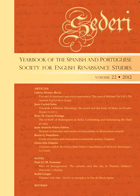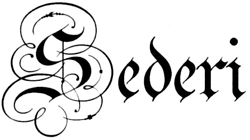
Sederi 22
Sederi 22 — 2012
EDITORS
Berta Cano Echevarría & Ana Sáez-Hidalgo
REVIEW EDITOR
Francisco J. Borge López
ISSN 1135-7789
Juan Antonio Prieto Pablos, “Women in breeches and modes of masculinity in Restoration comedy.” SEDERI 22 (2012): 69-91.
DOI: https://doi.org/10.34136/sederi.2012.4 Download PDF
Abstract
The dramatic tradition that featured female characters dressed in men’s costume was revived after the theatres reopened in the Restoration, with the difference that this time these roles were played by actresses. It has been argued that the contemplation of the female body reinforced the erotization of the actresses for the sake of predominantly male audiences. Their performances in “breeches roles” have also been interpreted as evidence of a progressive acknowledgement of the social possibilities of female agency. My own contention is that these roles did not only raise female agency to a level equal – if not superior, occasionally – to male agency, they also served to disrupt certain fashionable notions on the nature of masculinity, and therefore illustrate a trend that promoted new gender modes. To argue this thesis, I will focus on three comedies that represent as many stages in the development of this trend: the anonymous The Woman Turned Bully (1675), Thomas Shadwell’s The Woman Captain (1680), and Thomas Southerne’s Sir Anthony Love (1691), all of them featuring women wearing breeches and upsetting male order, with both comic and serious consequences.
Keywords: Restoration comedy; gender identity; masculinity; breeches roles.
References
Berkeley, D. S. 1952. “The Penitent Rake in Restoration Comedy.” Modern Philology 49: 223-233.
Breitenberg, Mark 1996. Anxious Masculinity in Early Modern England. Cambridge: Cambridge University Press.
Butler, Judith 1990. Gender Trouble: Feminism and the Subversion of Identity. London: Routledge.
Canfield, Douglas J. 1997. Tricksters and Estates: On the Ideology of Restoration Comedy. Lexington: University of Kentucky Press.
Cibber, Colley 1740. An Apology for the Life of Colley Cibber. London.
Drougge, Helga 1993. “‘We’ll learn that of the men’: Female Sexuality in Southerne’s Comedies.” Studies in English Literature 1500-1900 33/3: 545-563.
Dusinberre, Juliet 2003. Shakespeare and the Nature of Women. Houndmills: Palgrave Macmillan.
Fletcher, Anthony 1995. Gender, Sex and Subordination in England 1500-1800. New Haven: Yale University Press.
Freeburg, Victor 1915. Disguise Plots in Elizabethan Drama: A Study in Stage Tradition. New York: Columbia University Press.
Hitchcock, Tim and Michèle Cohen 1999. English Masculinities 1660-1800. London: Longman.
Howard, Jean 1988. “Crossdressing, the Theatre and Gender Struggle in Early Modern England.” Shakespeare Quarterly 39/4: 418-440.
Howe, Elizabeth 1992. The First English Actresses: Women and Drama 1660-1700. Cambridge: Cambridge University Press.
Hughes, Derek 1996. English Drama 1660-1700. Oxford: Clarendon Press.
Hume, Robert D. 1976. The Development of English Drama in the Late Seventeenth Century. Oxford: Oxford University Press.
Hume, Robert D. 1977. “The Myth of the Rake in ‘Restoration’ Comedy.” Studies in the Literary Imagination 10/1: 25-55.
Jardine, Lisa 1983. Still Harping on Daughters: Women and Drama in the Age of Shakespeare. Sussex: Harvester.
Kimmel, Michael 2005. “From Lord and Master to Cuckold and Fop: Masculinity in 17th-Century England.” The History of Men: Essays in the History of American and British Masculinities. New York: State University of New York Press: 125-142.
Kimmel, Michael S. 1997. “Masculinity as Homophobia: Fear, Shame, and Silence in the Construction of Gender Identity.” Eds. Mary M. Gergen and Sara N. Davis. Toward a New Psychology of Gender. London: Routledge: 223-242.
Kimmel, Michael S. 2003. The Gendered Society. New York: Oxford University Press.
Lowenthal, Cynthia 2003. Performing Identities on the Restoration Stage. Carbondale: Southern Illinois University Press.
MacDonald, Margaret L. 1976. The Independent Woman in the Restoration Comedy of Manners. Salzburg: Institute für englische Sprache und Literatur.
Maus, Katharine Eisaman 1979. “‘Playhouse Flesh and Blood’: Sexual Ideology and the Restoration Actress.” English Literary History 46: 595-617.
McKeon, Michael 1995. “Historicizing Patriarchy: The Emergence of Gender Difference in England, 1660-1760.” Eighteenth Century Studies 28/3: 295-322.
Mora, Maria José 2008. «Was Mary Lee the Woman Turned Bully?» Theatre Notebook 62/1: 4-6.
Mora, Maria José & al. eds. 2007. The Woman Turned Bully. Barcelona: Publicacions i Edicions Universitat de Barcelona.
Novy, Marianne 1984. Love’s Argument: Gender Relations in Shakespeare. Chapel Hill: University of North Carolina at Chapel Hill.
Rosenthal, Laura 1996. “Reading Masks: The Actress and the Spectatrix in Restoration Shakespeare.” Ed. Katherine M. Quinsey. Broken Boundaries: Women and Feminism in Restoration Drama. Lexington: The University Press of Kentucky: 203-218.
Rothstein, Eric and Frances Kavenik 1988. The Designs of Carolean Comedy. Carbondale: Southern Illinois University Press.
Shadwell, Thomas 1669. The Royal Shepherdess. London.
Shadwell, Thomas 1993 (1692). The Woman Captain: A Critical Old-Spelling Edition. Eds. Judith B. Slagle and Jack M. Armistead. New York: Garland.
Southerne, Thomas 1988. “Sir Anthony Love.” Eds. Robert Jordan and Harold Love. The Works of Thomas Southerne, vol. 1. Oxford: Clarendon Press: 157-257.
Staves, Susan 1979. Players’ Scepters: Fictions of Authority in the Restoration. Lincoln: University of Nebraska Press.
Stone, Lawrence 1979. The Family, Sex and Marriage in England 1500-1800. Harmondsworth: Penguin.
Weber, Harold M. 1986. The Restoration Rake Hero: Transformations in Sexual Understanding in Seventeenth-Century England. Madison: University of Wisconsin Press.
Williams, Andrew P. 1999. The Image of Manhood in Early Modern Literature: Viewing the Male. Westport: Greenwood Press.
Wilson, John H. 1958. All the King’s Ladies. Chicago: University of Chicago Press.
